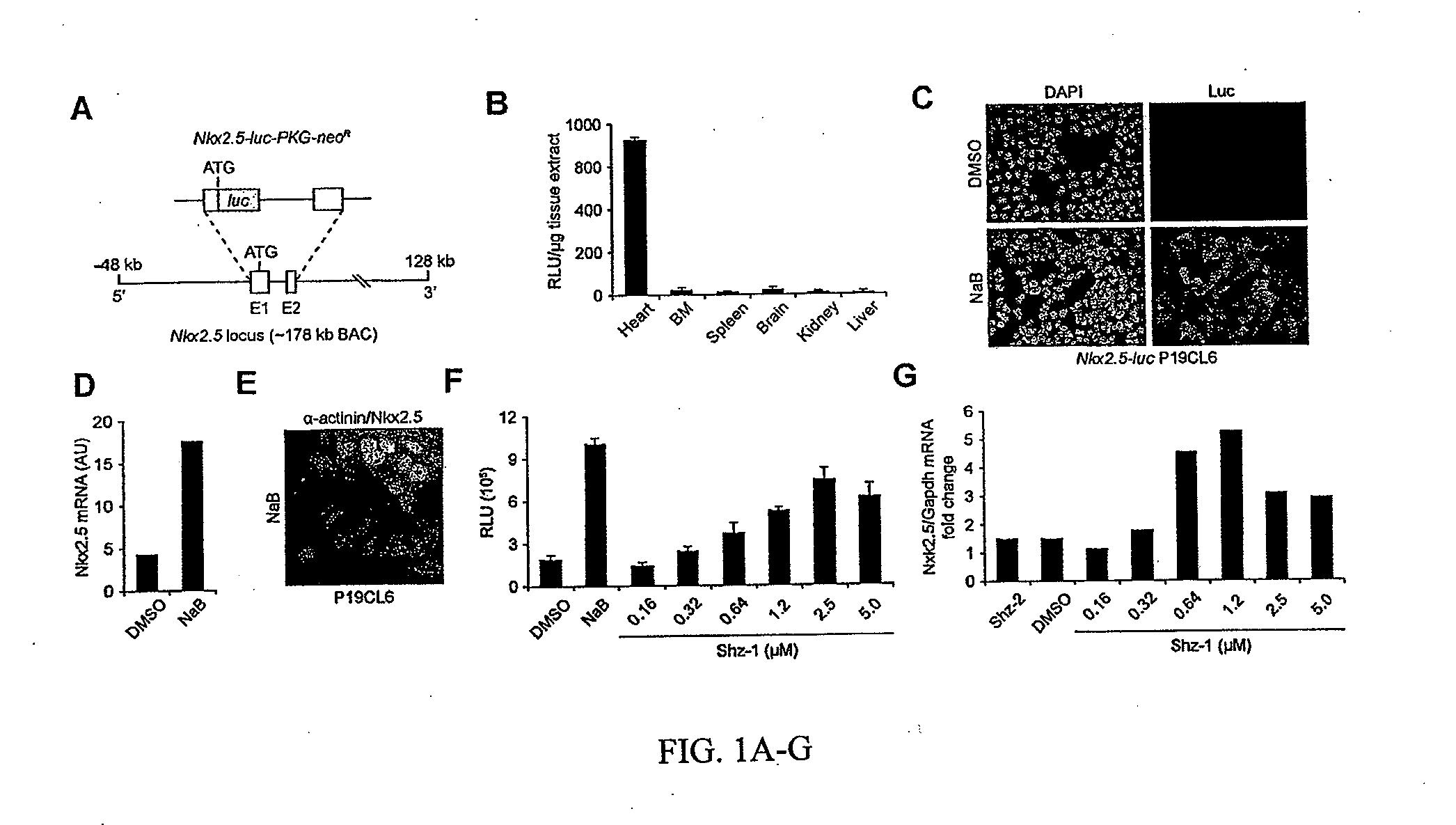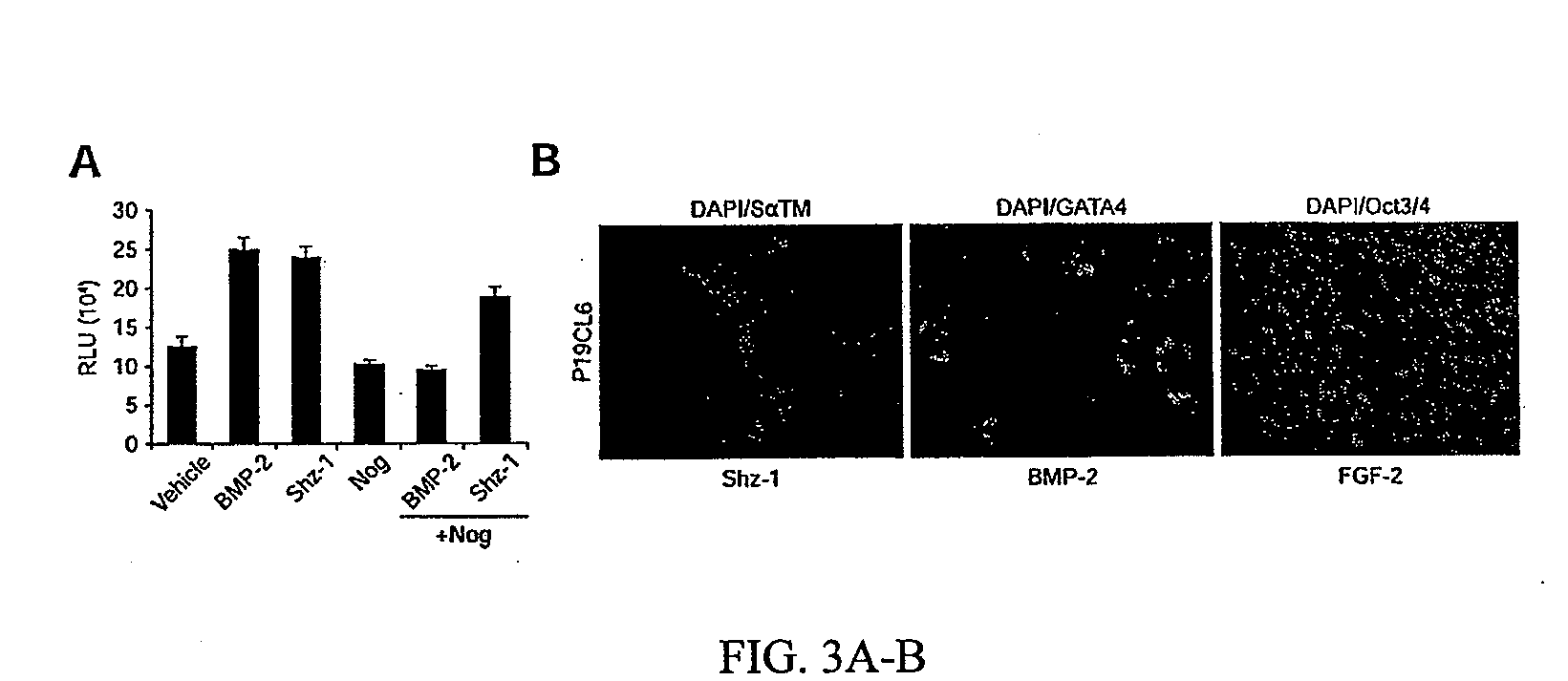Stem cell differentiating agents and uses therefor
a stem cell and differentiating agent technology, applied in the field of stem cell differentiation, can solve the problems of many basic scientific questions unanswered, and the endogenous stem cell repair mechanism is underpowered for tissue damage repair
- Summary
- Abstract
- Description
- Claims
- Application Information
AI Technical Summary
Benefits of technology
Problems solved by technology
Method used
Image
Examples
example 1
Materials & Methods
[0170]Chemical libraries and medicinal chemistry. The UTSW compound library used in this screen was purchased in two components, 47,000 unique compounds selected from the DiverSet™ small-molecules library (ChemBridge, Inc; San Diego, Calif.), 100,000 unique compounds from Chemical Diversity Labs, Inc. (San Diego, Calif.). This collection of compounds was additionally filtered to exclude compounds containing reactive groups and compounds likely to be insoluble or cytotoxic.
[0171]Assay development. An Nkx2.5-luc transgene was constructed by replacing the two coding sequence exons of Nkx2.5 locus from the ATG with the coding sequence of luc (from pGL3-basic vector, Promega) in an ˜180,000 base pair-long BAC (FIG. 1A). The recombinant BAC DNA was introduced into pluripotent P19CL6 cells using Lipofectamine-2000 (Invitrogen) and neoR clones were selected, and tested for chemically inducible luc activity with sodium butyrate (NaB). #5-1, a clonal stem cell line with low...
example 2
Results
[0183]Cardiogenic small-molecule screen. To identify cardiogenic small-molecules, the inventors screened ˜147,000 compounds in the UTSW chemical library for activators of the firefly luciferase gene (luc), inserted by homologous recombination (E. coli recombineering) into the Nkx2.5 locus on a 180-kilobase mouse BAC (FIG. 1A), stably integrated into the genome of P19 mouse pluripotent embryonal carcinoma cells, sub-clone CL6 (P19CL6) (Habara-Ohkubo, 1996). The inventors confirmed that the expression pattern of this recombinant Nkx2.5-luc BAC faithfully mirrored the endogenous gene by generating transgenic mice, which had luc activity exclusively in adult myocardium using bioluminescence and biochemical assay (FIG. 1B and FIG. 6A). The positive control compound for the Nkx2.5-luc BAC P19CL6 reporter cells was the histone deacetylase (HDAC) inhibitor, sodium butyrate (NaB), which strongly and reliably activated this transgene, demonstrated by luciferase immunostaining (FIG. 1C)...
example 3
Discussion
[0199]The inventors report a successful chemical library screen for chemical activators of the early cardiac genome in pluripotent stem cells and characterize a promising family of small-molecules that can both promote cardiac regenerative therapies and serve as mechanistic tools to gain insight into the biology that underlies cell fate decisions in stem cells. The Shz small-molecules were among the strongest inducers of the Nkx2.5 BAC reporter gene system to emerge from this primary screen of almost 150,000 compounds using genetically engineered P19CL6 pluripotent stem cells. the inventors tested Shz small-molecules in a number of confirmatory stem cell cardiac reporter gene assays, and validated their bioactivity by demonstrating specific induction of cardiac mRNAs and proteins. Most remarkably, Shz small-molecules activated the human cardiac genome in adult M-PBMCs, one of the most clinically viable sources of stem cells for cardiac therapy. Indeed, Shz small-molecules ...
PUM
| Property | Measurement | Unit |
|---|---|---|
| real time RT- | aaaaa | aaaaa |
| Protein blotting time | aaaaa | aaaaa |
| volume | aaaaa | aaaaa |
Abstract
Description
Claims
Application Information
 Login to View More
Login to View More - R&D
- Intellectual Property
- Life Sciences
- Materials
- Tech Scout
- Unparalleled Data Quality
- Higher Quality Content
- 60% Fewer Hallucinations
Browse by: Latest US Patents, China's latest patents, Technical Efficacy Thesaurus, Application Domain, Technology Topic, Popular Technical Reports.
© 2025 PatSnap. All rights reserved.Legal|Privacy policy|Modern Slavery Act Transparency Statement|Sitemap|About US| Contact US: help@patsnap.com



